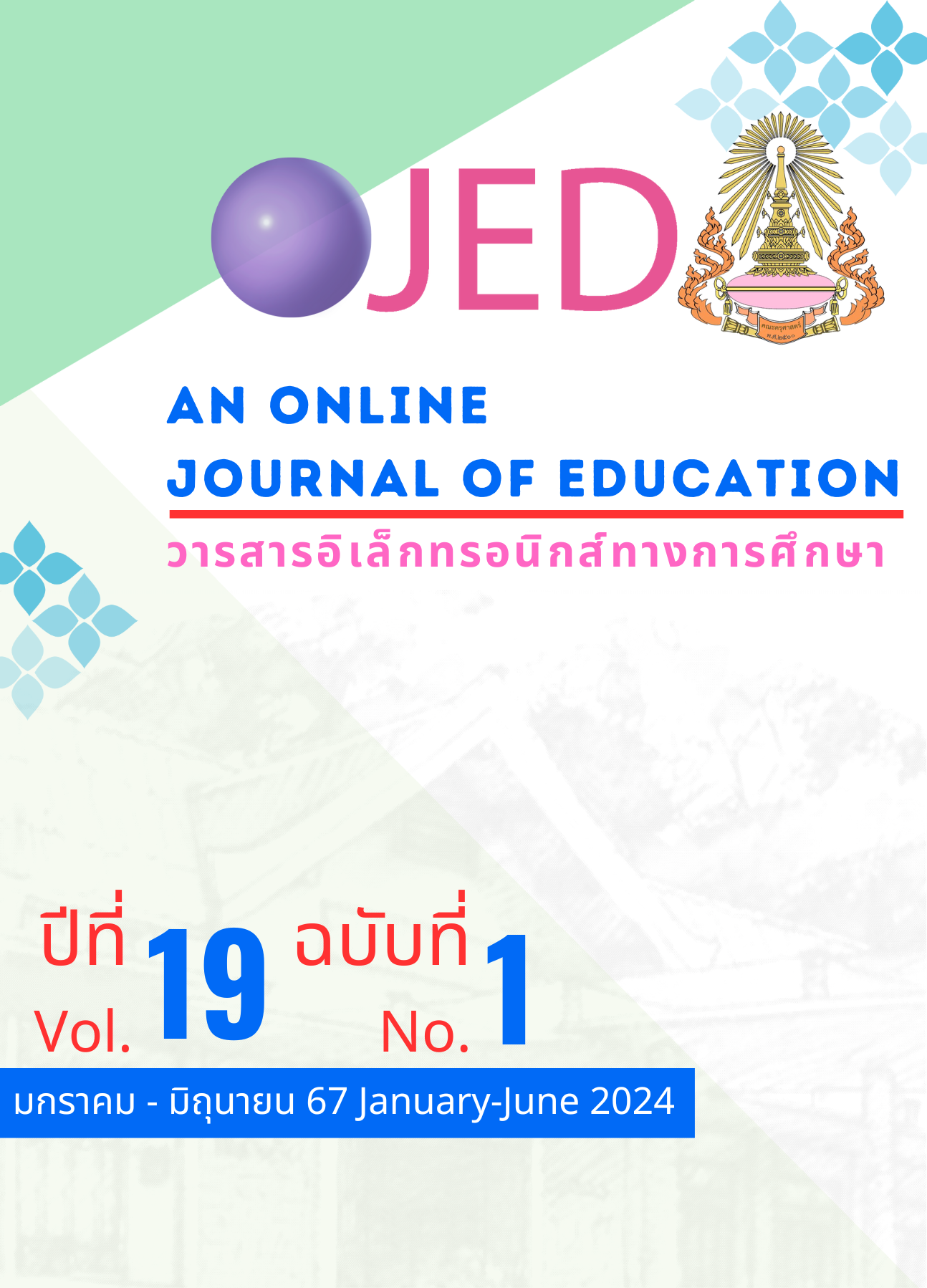Effects of Organizing Learning Activities Using Case-based Learning and Higher Order Questions on Media and Information Literacy of High School Students
Keywords:
media and information literacy, case-based learning, higher order questionsAbstract
This research aims to 1) compare students’ media and information literacy before and after employing a case-based learning approach combined with higher order questions, and 2) study students’ improvement in media and information literacy before, during, and after learning using this approach. The sample group used for the experiment consisted of grade 12 students at a school under the Nakhon Phanom Secondary Educational Service Area Office, selected using purposive selection, and the research method was a quasi- experimental design. The research instruments included an achievement test for evaluating students’ media and information literacy, observation forms, interview forms for evaluating students’ progress in media and information literacy, and lesson plans utilizing a case-based learning approach along with higher order questions. Quantitative data were analyzed by using mean, percentage, standard deviation, and t-test, while qualitative data were analyzed through content analysis. The findings showed that: 1) Mean post-test scores of students taught through learning activities using a case-based learning approach combined with higher order questions were significantly higher than pre-test scores at the 0.05 level of significance; and 2) students’ media and information literacy scores improved after the learning activities both in overall terms and when classified by each component.
References
ภาษาไทย
กระทรวงศึกษาธิการ. (2551). หลักสูตรแกนกลางการศึกษาขั้นพื้นฐานพุทธศักราช 2551. โรงพิมพ์ชุมนุมสหกรณ์การเกษตรแห่งประเทศไทย.
ขวัญฤทัย เที่ยงจันทราทิพย์. (2552). การจัดการเรียนรู้วิทยาศาสตร์โดยใช้กรณีศึกษาเป็นฐาน (Case based learning). สอนสนุก-สนุกสอน, 38(163), 60-61.
ทิศนา แขมมณี. (2562). ศาสตร์การสอน : องค์ความรู้เพื่อการจัดกระบวนการเรียนรู้ที่มีประสิทธิภาพ (พิมพ์ครั้งที่ 23). สำนักพิมพ์แห่งจุฬาลงกรณ์มหาวิทยาลัย
พิมพันธ์ เตชะคุปต์. (2543). แนวคิดและแนวทางของการจัดการเรียนการสอนที่ยึดนักเรียนเป็นศูนย์กลาง. สถาบันพัฒนาวิชาการ.
วิจารณ์ พานิชย์. (2555). วิถีสร้างการเรียนรู้เพื่อศิษย์ในศตวรรษที่ 21. มูลนิธิสดศรี-สฤษดิ์วงศ์.
สถาบันสื่อเด็กและเยาวชน. (2562). ตัวบ่งชี้การรู้เท่าทันสื่อสารสนเทศและดิจิทัลระดับบุคคลเพื่อส่งเสริมความเป็นพลเมืองประชาธิปไตย. http://cclickthailand.com/ตัวบ่งชี้การรู้เท่าทัน/
สรียา ทับทัน. (2557). การรู้เท่าทันสื่อและสารสนเทศ. วารสารครุศาสตร์อุตสาหกรรม, 13(2), 1-6.
สำนักงานคณะกรรมการการศึกษาขั้นพื้นฐาน. (2558). แนวทางการจัดทักษะการเรียนรู้ในศตวรรษที่ 21 ที่เน้นสมรรถนะทางสาขาวิชาชีพ. กรุงเทพฯ: โรงพิมพ์ชุมนุมสหกรณ์การเกษตรแห่งประเทศไทย จำกัด.
สำนักงานคณะกรรมการดิจิทัลเพื่อเศรษฐกิจและสังคมแห่งชาติ. (2563). รายงานผลการสำรวจข้อมูลสถานภาพการรู้เท่าทันสื่อและสารสนเทศของประเทศไทยปี พ.ศ.2562. https://itm.eg.mahidol.ac.th/itm/wp-content/uploads/2020/04/MDES-ONDE-MIL-Survey-2019-ภาพรวมประเทศ.
pdf?fbclid=IwAR2z8F716sPqXR0Low97AEaaqjiZtnPKb7uYmvRhkQAcOeuTJG_qZin3MoQ
สำนักงานเลขาธิการสภาการศึกษา. (2560). แผนการศึกษาชาติ พ.ศ.2560 – 2579. บริษัทพริกหวานกราฟิค จำกัด.
สำนักงานสถิติแห่งชาติ. (2563). การสำรวจการมีการใช้เทคโนโลยีสารสนเทศและการสื่อสารในครัวเรือน พ.ศ. 2562. https://www.nso.go.th/nsoweb/nso/survey_detail/jJ?set_lang=th
อรศรี งามวิทยาพงษ์. (2551). รายงานผลการศึกษากระบวนการเรียนรู้สู่การเท่าทันสื่อ : บทสำรวจสถานภาพและก้าวต่อไป. สำนักงานกองทุนสนับสนุนการสร้างเสริมสุขภาพ.
อัมพร ม้าคนอง. (2552). การพัฒนามโนทัศน์ทางคณิตศาสตร์โดยใช้โมเดลการได้มาซึ่งมโนทัศน์และคำถามระดับสูง. วารสารครุศาสตร์, 37(3),1-13.
อุษณี กังวารจิตต์. (2559). การรู้เท่าทันสื่อสังคมออนไลน์ของเด็กและเยาวชน. วารสารรัฏฐาภิรักษ์, 53(3), 80 – 92.
ภาษาอังกฤษ
Bautista Jr, A. (2021). Teaching Media and Information Literacy in Philippine Senior High Schools: Strategies Used and Challenges Faced by Selected Teachers. Asian Journal on Perspectives in Education, 1(2), 22 – 23.
Blackmon, M., Hong, Y., & Choi, I. (2007). Case-Based Learning. In M. Orey (Ed.), Emerging perspectives on learning, teaching, and technology. (174 - 177). Retrieved from https://textbookequity.org/Textbooks/Orey_Emergin_Perspectives_Learning.pdf
Center of Teaching and Learning. (2022). Case Method Teaching and Learning. https://ctl.columbia.edu/resources-and-technology/resources/case-method/
Chi-kim Cheung a., & Connie Chau. (2017). Implementing Media Literacy Education in the Junior Secondary English Curriculum in Hong Kong: Reasons and Limitations. International Journal of Media and Information Literacy, 2(2), 61-67. http://dx.doi.org/10.13187/ijmil.2017.2.61
Flynn, A. E., & Klein, J. D. (2001). The influence of discussion groups in a case-based learning environment. Educational Technology Research and Development, 49(3), 71-86.
Herreid, C. F. (2013). ConfChem Conference on Case-Based Studies in Chemical Education: The Future of Case Study Teaching in Science. Journal of Chemical Education, 90(2), 256-257. https://doi.org/10.1021/ed2008125
Kathleen, C. (2019). Classroom questioning. Education Northwest. https://educationnorthwest.org/resources/classroom-questioning
McLean SF. (2016). Case-based learning and its application in medical and health-care fields: A review of worldwide literature. Journal of Medical Education and Curricular Development, 3(3), JMECD.S20377. https://doi.org/10.4137/jmecd.s20377
Parman, P., Nurwahida, N., & Syam, A. (2020). Questioning stratrgies analysis :Teacher’practice and student’view. In The second international conference on English education.
Patricia Bogdanovich. (2014). Higher-order Questions. https://dataworks-ed.com/blog/2014/10/higher-order-questions/
UNESCO. (2013). Global Media and Information Literacy Assessment Framework: country readiness and competencies.https://unesdoc.unesco.org/ark:/48223/pf0000224655/PDF/224655eng.pdf.multi

Downloads
Published
How to Cite
Issue
Section
License
Copyright (c) 2024 An Online Journal of Education

This work is licensed under a Creative Commons Attribution-NonCommercial-NoDerivatives 4.0 International License.


